How did a small island nation conquer as much as a quarter of the globe? How did he manage to subdue the nations of five continents? The British Empire was the greatest power of the modern West when the United States was still in its infancy. The foundations for British domination in the oceans were laid, among others, by fearless sailor and corsair - Francis Drake.
At the height of their power, the British controlled an area of 38 million square kilometers, inhabited by over 475 million people. It was the largest empire in human history - built by an average island nation on the outskirts of Europe.
The colonial power of the British from India to the Caribbean, and from Africa to Australia, left its mark on every country that was influenced by them. Traces of islanders' supremacy are still present in former colonies and still fascinate today. They were followed by journalist Michael Portillo, who hosts the documentary series on Polsat Viast History TV "The British Empire through the eyes of Michael Portillo".
Sea tales
Volumes of research have been written, trying to pinpoint the source of British power, but in the end it would never have been born had it not been for an act of will - the islanders' ambition to establish themselves at the forefront of the race of nations to explore the New World.
The colonial era - with the discoveries of Columbus - was started by the Spaniards, Europe's greatest maritime power at that time, and the Portuguese. Already three years after Columbus reached the Caribbean, King of England Henry VII Tudor, irritated by the successes of Spain, ordered the sailor John Cabot to find an alternative route to Asia (at that time it was still thought that Columbus had reached the West Indies) via the North Atlantic. Cabot took on the task, but made it to Newfoundland instead of Asia.
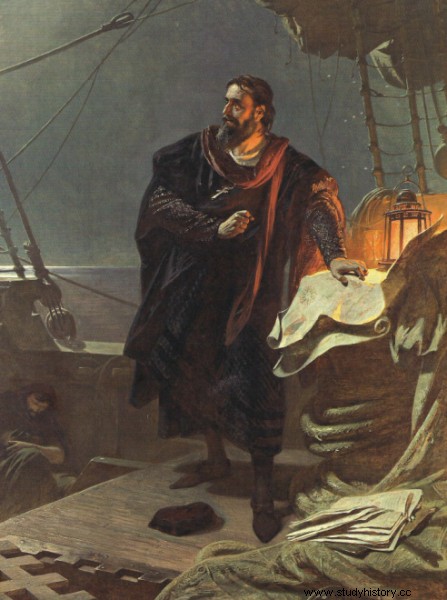
The colonial era - with the discoveries of Columbus - was started by the Spaniards
With the Great Armada, the Spaniards ruled the oceans. They seemed unbreakable, but in 1562 an English seaman Francis Drake got official permission from the throne to trade slaves . He could attack Spanish and Portuguese ships without any problems. Thus, the English accepted privateership as a method of fighting for economic and political influence.
From poverty and fanaticism to the open ocean
The biography of Francis Drake is an ideal illustration of a career from a bootblack to a millionaire. He was raised as the eldest of twelve children in a family of fanatical Protestants. They lived in poverty in the city of Kent, in a crumbling and leaking ship. So Łajba has always been home to Drake. From the age of 12 he worked on ships as a ship boy.
Fortunately, someone like the good fairy from the Cinderella fairy tale appeared in its story. I am talking about a distant relative - the magnate and sailor Sir John Hawkins. Thanks to him, the boy received his education. He also allowed him to acquire skills in nautical art. At just 18, Drake commanded a ship on his own for the first time sailing from England to the Bay of Biscay.
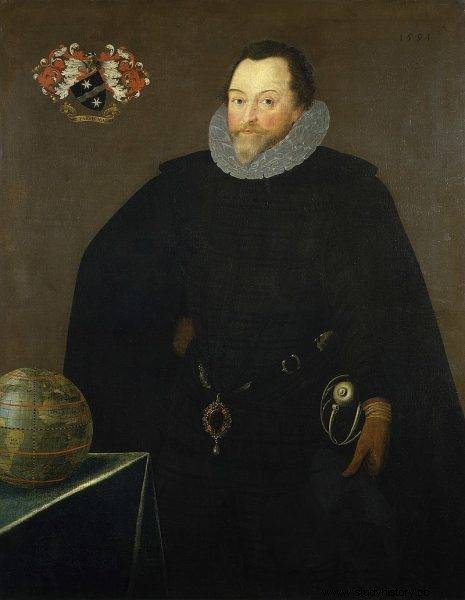
At just 18 years of age, Drake first commanded a vessel from England to the Bay of Biscay on his own.
It worked. England was very much needed by the capable and ready to fight. In the early stages of colonialism, pushing through the New World was ruthless. The English could not afford an open sea war with the Spanish power. Drake was ordered to embark on a reconnaissance mission to the Caribbean, so far dominated by the Spanish.
Caribbean Gambit
He set off with his cousin - Hawkins, but the beginnings were not promising. The Spaniards dragged them into a trap. They drove to the vicinity of Veracruz, where Armada's ships were waiting. The English ships were almost completely destroyed.
Drake barely survived, but despite the failure of the first expedition, gained favor with the throne. He obtained permission to organize another which he eagerly set out to recruit anyone who was loyal and willing to work hard, and especially those who had conflicts with the Spaniards and hated them with all his heart. On board the Drake there were many blacks already recruited in the New World who escaped from Spanish captivity.
He set out on a second expedition from Plymouth in 1572. His squadron consisted of only two ships - 70 men in total. After 25 days of travel, he was in the Caribbean. He planned to take the Spanish city of Nombre de Dios on the Atlantic coast of present-day Panama. His men broke into an unprotected settlement, but the success was only partial.
They ran out of firepower. The rain soaked the gunpowder. Drake had to withdraw and be content with an attack on the Spanish convoy with gold, but here too he was disappointed. The Spaniards were aware of the presence of British privateers and equipped the convoy with a military escort.
The attackers, who suddenly emerged from the dense Panama jungle, suffered a painful defeat. They had to run away. Even so, Drake did not give up on gold. The attack on another convoy was successful. As many as 190 mules laden with precious ore and other valuables fell into English hands.
In 1573, Drake returned to Plymouth. He was feted like a winner. While the Spanish throne demanded that the pirate be punished, Queen Elizabeth ostentatiously invited him to her presence. The audience was supposed to show the rival that the English court treats the daredevil as a privateer, i.e. a captain who fought and looted "legally" - on behalf of the English court.
Around the world
Successful escapades to the Caribbean were just the beginning of the game for the New World. Queen Elizabeth's corsair, as his contemporaries and descendants called him, was given a truly ambitious task - to attack the Spaniards, but in their outposts on the west coast of Latin America.
For this purpose, it was necessary to go on a journey that only a few decades earlier had been discovered by the Portuguese sailor Ferdinand Magellan for Europeans. The strait named after him, on the outskirts of South America, connecting the Atlantic and Pacific oceans, was still a route largely unknown. It could cause anxiety in people of the sea.
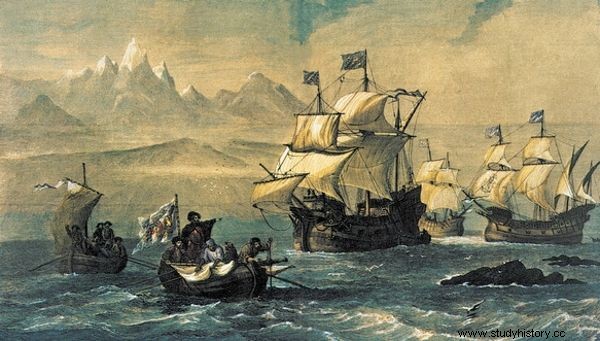
For this purpose, it was necessary to go on a journey that only a few decades earlier had been discovered by the Portuguese sailor Ferdinand Magellan for Europeans. " The British Empire through the eyes of Michael Portillo" Premiere of Poslat Viasat History:Sunday 11 July at 19:45
The queen's corsair prepared for the expedition very carefully. He obtained the support of wealthy protectors and the necessary funding. The court itself quietly provided money for this expedition. Ultimately, we managed to put up 5 units: The 80-ton ship Elisabeth, the 150-ton Golden Hind, the little ship Marygold and two support ships with supplies. The squadron consisted of 164 sailors.
Drake was aware that an expedition into the unknown could be met with reluctance by the brothers' seafarers, so until the very end it was officially announced that the expedition was to be a "trade cruise to Alexandria".
The ships set out on December 13, 1577. Their first target was the Portuguese captured Cape Verde. Here British corsairs got into a successful skirmish with Portuguese units. It is true that they did not capture the treasures, but they took over one ship, and a certain Da Silva, a navigator well acquainted with the waters of the Atlantic, was taken into captivity in England. Thanks to his help, after 54 days of voyage, the English ships found themselves on the outskirts of South America.
Drake had to cross the Strait of Magellan. Then the fate of the expedition hung in the balance.
Magic in the ocean
A man named Thomas Doughty, Drake's longtime companion on his expeditions, rioted on board. He conspired against the captain, and the background was offended ambition. Doughty - an aristocrat of origin, could not stand that the cards in the expedition were dealt by a native of Drake. What's more - due to the dispute over the captured property on the ship Santa Maria seized from the Portuguese, Doughty was degraded by Drake. Eventually, he was given command of the smallest unit in a squadron.
Today it is not known whether the death sentence on the alleged traitor had real grounds, or whether it served to strengthen Drake's position among the crew before the difficult journey, or maybe it was the result of settling accounts with a former companion who allegedly conspired at the English court with the opponents of the expedition.
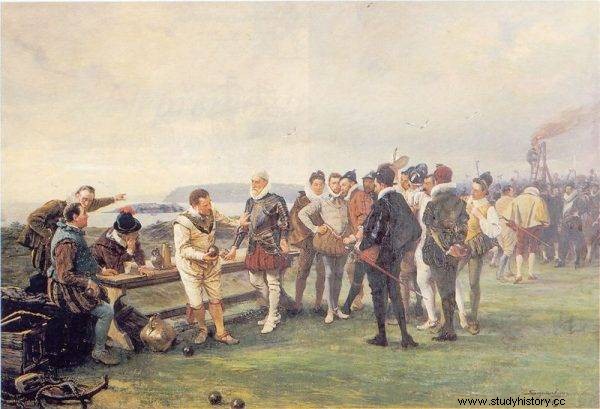
Drake was aware that an expedition into the unknown could be met with reluctance by the brothers' seafarers, so until the very end it was officially announced that the expedition was to be a "trade cruise to Alexandria".
In any case, Drake accused Doughty of not only mutiny, but also witchcraft - when the Swan sank during the storm. So he announced to the crew and - so that there was no doubt who was in charge here - ordered the death sentence to be carried out by beheading. It also happened.
On the other side
On September 7, 1577, the expedition crossed the Strait of Magellan. The ends of the world took their toll on the corsairs. The Pacific greeted the daredevils with fury. Storms and hurricanes led to the destruction of other ships. Eventually, Drake and his men sailed from the Atlantic to the Pacific on only one Golden Hind. Elisabeth and Marygold were lost in the sea, and Drake himself was pushed further south - thus circumnavigating Cape Horn, marking - unknowingly of course - a route later called the Drake Strait .
Despite the thinning of the squadron, he continued his expedition with only one ship. He and his men were already sailing north in the Pacific.
The British in these waters have so far been an unheard of phenomenon. The Spaniards freely loaded the gold from the colonies onto the heavily loaded merchant ships, without really thinking about protecting them.
Luckily, the corsairs did not hesitate to take advantage of it. First, they sacked the port city in today's Chile - Valparaiso, taking many silver and valuables from the local church and townspeople's houses. There they also robbed a Spanish ship anchored in the port, on which there were 25 thousand. bottles of Chilean wine, 25 thousand. pesos in gold and coast maps. To this day, in the Valparaiso area, there is a legend that a part of Drake's treasure was to be hidden in one of the caves of the rocky coast.
Flamethrower
It was merely a prelude. In Peru, they plundered several Spanish properties, incl. port of Callao, however, the fat bite was yet to come. The captive Indian, who genuinely hated the Spaniards, told them about a great galleon full of silver carrying all the annual ore from mines that had just sailed north towards Panama.
Drake didn't hesitate for a second. He set out in pursuit to catch up with the 120-ton Spanish galleon Nuestra Señora de la Concepción, near Esmeraldas, Ecuador, on March 1, 1579.
When a ship laden with valuables, due to its large cannons called "Cacafuego" or "Flamethrower" , appeared to the eyes of the English, Drake ordered everything to appear as if they were sailing for commercial purposes. He waited until dusk. When night fell, the English demanded the captain of the vessel surrender. He refused, so they began boarding. Cannons, muskets, arquebuses, crossbows and rapiers were in motion.
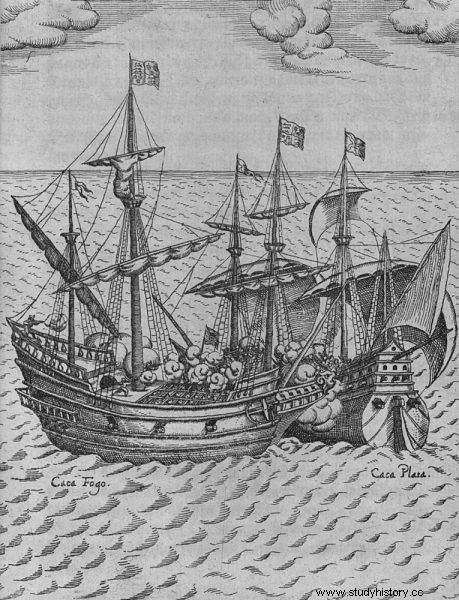
Drake didn't hesitate for a second. He set off in pursuit to catch up with the 120-ton Spanish galleon Nuestra Señora de la Concepción after a few weeks, on March 1, 1579.
Eventually, the Spaniards were defeated, and Drake led the captured galleon into calm waters to dock in one of the bays and unpack its contents. It took four days. Apparently pirates took from the ship a lot of exotic goods - fabrics and spices, also jewelry, precious stones, 26 tons of silver, 13 chests full of silver coins, 40 kg of gold in bars . The value of the loot was estimated at 250,000. pounds sterling, or about $ 50 million , a hundred times the cost of Drake's expedition.
What happened to all of this? It is not known. If everything was packed on the English ship, it would sink to the bottom.
Apparently, Drake was gallant towards his rivals. He sat down together at the table with the Spanish officers, ate a festive dinner with them and enjoyed wine - of course the won. In turn, he was to give the prisoners away with gifts.
New Albion
The Drake's corsair raid along the American west coast took the Spaniards by surprise and broke their supremacy in the Pacific. Although the Spanish crown, alerted by the large number of attacks, ordered the pursuit of the daredevils, Drake remained elusive.
He continued his expedition farther north, reaching North America. The beautiful, sunny California charmed him so much that he gave it the name New Albion. Eventually, it reached the borders of Canada and the USA. He tried to circumnavigate the American continent north and return to the Atlantic, but failed. Despite the long journey, the road to the Atlantic was still blocked by land. At that time, the Europeans had no idea how gigantic the American continent was. The so-called The Northwest Passage - through the Arctic Archipelago - was only crossed in the 19th century.
Eventually, Drake "broke" off the American coast and headed towards East Asia. Reportedly, the sailors exploring unknown lands were so scared that they would be lost at the ends of the globe when their captain is killed or taken prisoner that they forbade Drake to go ashore during his visit to the Ternate Island in the Moluccan archipelago and in Java.
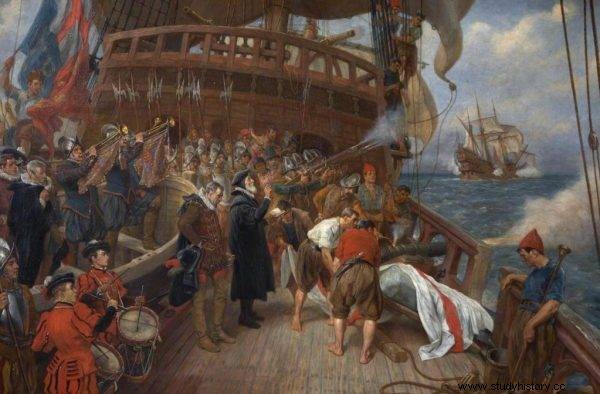
Drake's funeral
After sailing around Africa and traveling around the world the Golden Doe on September 26, 1580, reached the home port of Plymouth. The expedition lasted nearly 3 years. It turned out to be a spectacular success, making the captain a celebrity at the time, an influential and wealthy man.
Queen Elizabeth granted him a knighthood and elevated him to the rank of admiral. The ceremony took place on board the Golden Hind. Since then, the corsair has also carried out official diplomatic missions for the emerging English colonial power. It is worth noting that in 1586 he brought the first shipment of tobacco from the Caribbean islands to England, thus contributing to the spread of the fatal nicotine addiction in the Old Continent.
He also did not give up the war. He fought fiercely with the Spanish Great Armada. In 1581 he captured Santo Domingo in the Caribbean. He attacked Spanish ports, but also defended the British coast from enemy invasion. He took part in the defeat of the English Channel Armada in 1588.
Until the end of his life, he commanded privateer expeditions. Died of dysentery during an expedition to the West Indies, the Caribbean. The body of the great explorer and sailor rested in a lead coffin in the depths of the sea. The funeral ceremonies were accompanied by a cannonade from the cannons. Two captured ships were also set on fire.
Bibliography:
- Angus Konstam, The Spanish Galleon 1530–1690 , Osprey Publishing (UK) 2004.
- Angus Konstam, Tudor Warship (2):Elizabeth I’s Navy , Osprey Publishing (UK) 2008.
- Sam Bawlf, The Secret Voyage of Sir Francis Drake, 1577–1580, Walker and Co, 2003.
- Franklin W. Knight, Colin A. Palmer, The Modern Caribbean, University of North Carolina Press, 1989.
- Piotr Oborski, On the seas and oceans, Warsaw:National Publishing Agency, 1982.
